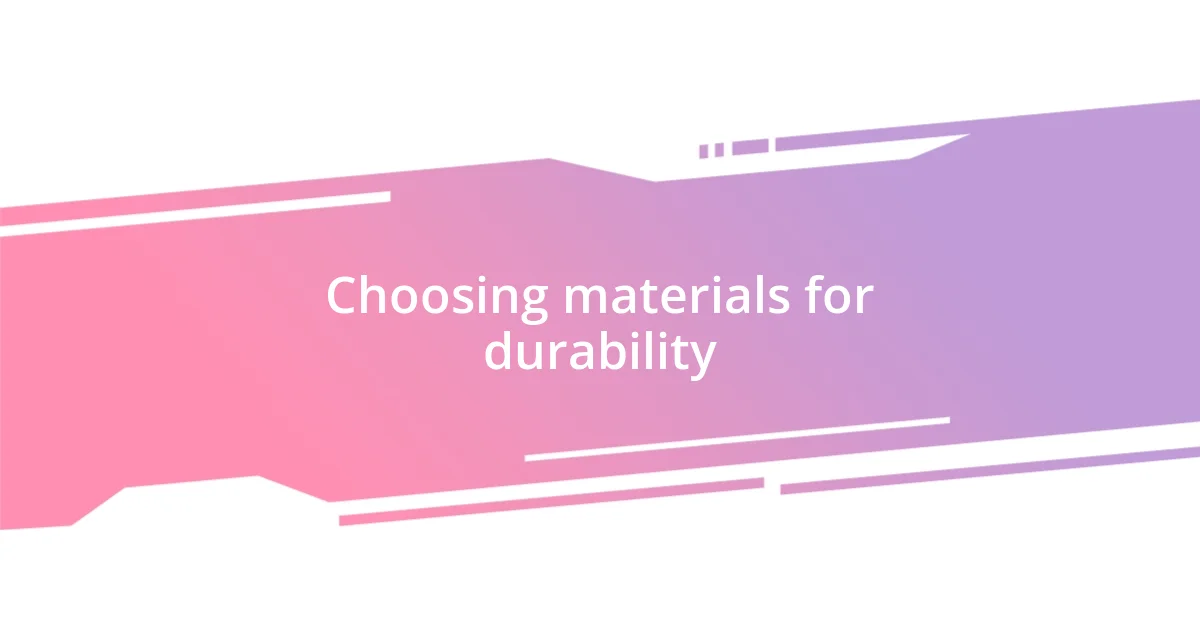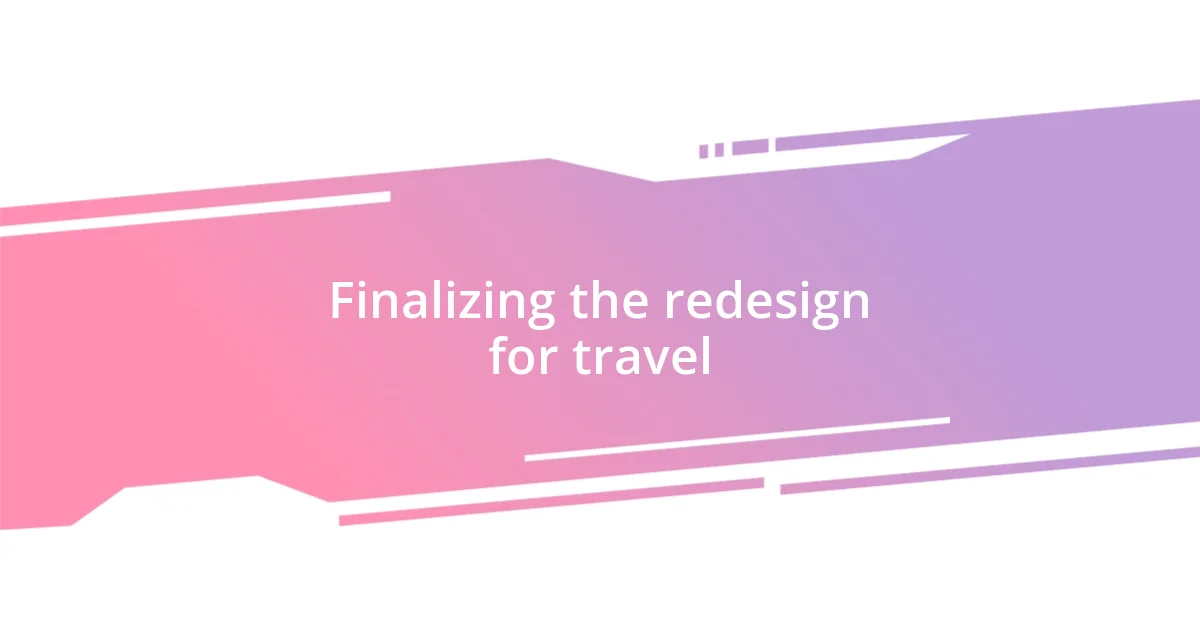Key takeaways:
- Identifying personal travel comfort needs involves reflecting on past discomforts and prioritizing items that enhance emotional well-being and support.
- Innovative solutions, such as ergonomic designs and high-quality materials, significantly improve the functionality and durability of travel comfort items.
- Testing and user feedback are crucial in refining designs, ensuring inclusivity and adaptability to different travelers’ needs and contexts.

Identifying travel comfort needs
When it comes to identifying my travel comfort needs, I always start by reflecting on my past experiences. There was that long-haul flight where I ended up with a stiff neck—never again! I realized that my neck pillow just wasn’t cutting it; it needed more support. Have you ever faced discomfort that ruined the travel experience?
I began assessing various situations that caused discomfort during trips. From cramped airplane seats to those uncomfortable nights in unfamiliar beds, each experience led me to rethink my essentials. I found myself asking: what actually makes me feel at ease while traveling? That little moment of clarity pushed me toward redesigning items that not only serve a purpose but also enhance my overall journey.
I’ve learned that personal preferences play a huge role in comfort. For instance, I can’t take a flight without my cozy, oversized blanket—it brings a sense of home wherever I am. Have you considered how your emotions influence your comfort items? Understanding these needs means creating a travel kit tailored just for you, making each adventure just a bit more enjoyable.

Recognizing ineffective travel items
Recognizing ineffective travel items can be a game changer, particularly when you’ve experienced discomfort that lingers long after the trip. I remember packing an over-the-ear headphone set for a 12-hour flight, only to find them heavy and cumbersome. Halfway through, my ears ached, and I missed out on enjoying my favorite podcast. It was a clear sign that just because something seems convenient doesn’t mean it fits my travel lifestyle.
To help you identify items that might be wasting precious space in your luggage, consider the following:
- Are they bulky or excessively heavy?
- Do they lack versatility and serve only one specific purpose?
- Have they caused discomfort or pain during travel?
- Are they outdated or no longer aligned with your needs?
- Do they take too long to set up or use when you need them most?
Being mindful of these factors can transform the way you approach your packing list, letting you ditch the ineffective items and focus on what truly enhances your journey.

Researching innovative comfort solutions
When diving into innovative comfort solutions, I found myself captivated by the latest trends in travel accessories. One of my favorite discoveries was a compact travel pillow featuring adaptive memory foam. Unlike traditional neck pillows, this one molded perfectly to my neck’s contours and offered support during those endless flights. Have you ever felt your pillow just isn’t doing its job? Experiencing that moment of relief made me realize the importance of finding products that can adapt to our unique needs while traveling.
In my quest, I stumbled upon several startups that innovated with materials I’d never seen before. For instance, the concept of ‘breathable’ fabrics intrigued me. I tested a travel blanket made from a fabric that allows airflow while also retaining heat, which is perfect for cold airplane cabins. I remember using it during a chilly evening flight; it felt like being wrapped in a gentle hug without the sweat. Bringing this emotional connection into comfort solutions is something I now prioritize in my redesign process.
Throughout this exploration, I compared various innovative comfort items with what I previously relied on. Most solutions went above and beyond standard designs, addressing specific pain points I faced. Through trial and error, I learned that comfort should combine both functionality and emotional well-being, leading to a travel experience that feels personalized and enjoyable.
| Comfort Item | Innovative Solution |
|---|---|
| Traditional Neck Pillow | Adaptive Memory Foam Pillow |
| Regular Travel Blanket | Breathable Fabric Blanket |
| Standard Earbuds | Noise-Canceling Earbuds |
| Old-fashioned Sleep Mask | Light-Blocking, Adjustable Mask |

Choosing materials for durability
When it comes to choosing materials for durability, I’ve learned to prioritize high-quality fabrics over cheaper alternatives. On a recent trip, I invested in a nylon carry-on bag that not only held up against wear and tear but also easily shrugged off spills. This experience made me realize that a little extra spending on robust materials can save you money and frustration down the line—after all, have you ever had to replace a flimsy bag mid-journey?
I also pay attention to the stitching and hardware on travel items. I vividly recall using a phone holder that seemed ideal until it broke apart within a week. The cheap plastic clips simply couldn’t withstand the constant adjustments and wear from travel. Now, I always check for reinforced stitching and sturdy zippers. It’s a small detail, but it can significantly impact the longevity of your items.
Additionally, I’ve found that materials like ripstop fabric and breathable mesh not only increase durability but also enhance overall comfort. During a long camping trip, my choice of a ripstop tarp really paid off when strong winds hit; it didn’t tear, ensuring my gear stayed protected. When selecting materials, think about both their resilience and how they can improve your travel experience. Do they provide flexibility or ease of care? These factors are essential in creating reliable travel comfort items that you can count on, day in and day out.

Designing ergonomic shapes
Designing ergonomic shapes has been one of the most enlightening aspects of my redesign journey. I took a close look at how traditional items failed to support the natural contours of the body, which can leave travelers feeling stiff and uncomfortable. For example, I once had a travel pillow that did little more than prop my head awkwardly. It made me wonder, what if comfort could come from a design that truly understands our anatomy instead of simply serving a generic purpose?
Through experimentation, I began reshaping items with my own body mechanics in mind. I vividly recall crafting a travel neck pillow that curves at just the right angle, alleviating pressure points. After testing it on a long-haul flight, I was surprised to find that I could finally nod off without constantly adjusting my position. Have you ever experienced that blissful moment when everything just feels right? It’s in those small victories that I realized ergonomic design isn’t just about comfort; it’s about enhancing the entire travel experience.
For me, the idea of tailoring these forms to fit individual use is crucial. I sought to capture the essence of what it means to travel comfortably by designing shapes that effortlessly wrap around the user, preventing discomfort and strain. Designing a portable lumbar support cushion was another highlight; it gave passengers the additional support they desperately need during those extended hours in cramped airplane seats. How simple tweaks in shape can create a significant difference—it’s truly remarkable!

Testing adjustments for comfort
Testing adjustments for comfort has been essential in refining my travel comfort items. I remember the day I decided to tweak the thickness of my travel pillow. The first version felt great during brief trials, but on a 12-hour flight, it quickly became clear that it was too fluffy. After a few adjustments, finding the perfect balance created a pillow that cradled my neck without collapsing under the weight of my head. Isn’t it fascinating how such a small change can dramatically affect your comfort level?
Engaging with different settings also played a critical role in my testing process. I once took my redesigned lumbar support cushion to a cozy café, where I spent hours working on my laptop. Initially, I thought the cushion was perfect, but an afternoon spent sitting revealed that I had actually overcompensated and created a design that was too rigid. Adapting my design on the fly, I softened the cushioning slightly to provide a more forgiving support without sacrificing stability. It’s these real-world tests that truly illuminate how comfort can be subjective and context-dependent.
Finally, user feedback became an invaluable source of insight. During a weekend trip, I lent my redesigned eye mask to a friend who shared my penchant for travel, but with a much smaller face. I noticed her struggle to adjust it correctly, which made me realize I needed to include adjustable straps in the design. What I once thought was a one-size-fits-all solution wasn’t working for everyone. These moments taught me that comfort isn’t merely a matter of personal preference—it’s about creating solutions that invite inclusive experiences while keeping everyone’s comfort in mind.

Finalizing the redesign for travel
Finalizing the redesign for travel was a process that demanded my full attention. I remember sitting on my living room floor, surrounded by fabric swatches and prototypes, eager to put my finishing touches on my items. That moment felt electric, as if I were on the verge of discovering something groundbreaking. After countless iterations, the designs finally began to embody both comfort and functionality—like the way a favorite hoodie wraps around you on a chilly day.
As I prepared to finalize the details, I felt a sense of anticipation mixed with doubt. Was I doing justice to the comfort needs of fellow travelers? I vividly recall taking my redesigned travel pillow on a weekend getaway. I was nervous to see how it would perform in real travel conditions. To my delight, when I finally rested my head on it during a bumpy train ride, I felt the anxiety melt away. Isn’t it incredible how a well-designed item can transform your experience?
Ultimately, the culmination of my redesign journey felt personal. Each comfort item was crafted not just for me, but with the intent to enhance the travel experiences of others as well. I wanted every traveler to find solace in a small piece of thoughtful design, just as I had after hours of refining my concepts. As I completed the final details, I felt like I was offering a piece of myself with each item, ensuring they would resonate with anyone seeking comfort and ease while on the move.













